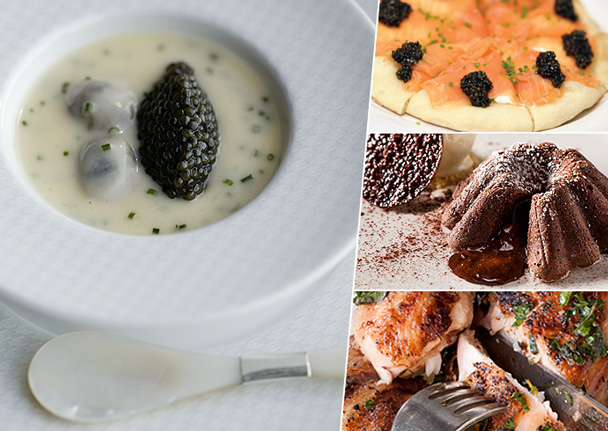Oysters and Pearls. Black Cod with Miso. Smoked Salmon Pizza. These are dishes that are so iconic that the mere thought of them can evoke the faces of the culinary masterminds who created them: Thomas Keller, Nobu Matsuhisa, Wolfgang Puck. Regardless of the countless other recipes these chefs create, it is their signature dish they most likely will be remembered for, whether they intended it or not.
A truly successful culinary creation is one that stands the test of time, and according to hospitality consultant Karine Bakhoum, can even immortalize its maker. "It's a dish that people are drawn to and talk about before they have it, while they're having it, and after they have it," Bakhoum says. It must be memorable, embraceable, replicable, and above all else, consistent.
The motivations behind the creation of a signature dish are sometimes different for a restaurant versus a chef. "A chef may want to showcase an incredible presentation, ingredient, or heritage," says Steve Zagor, a restaurant consultant and Dean of Culinary Business and Industry Studies at the Institute of Culinary Education. "But a restaurant often looks at it from more of a business perspective, such as whether that dish can transcend a location, or whether it's really a dish they can make money on." Despite chefs' and restaurants' hopes, it's not as simple as just labeling it on the menu as the chef or eatery's centerpiece.
"I think for something to be defined as a 'signature dish,' it's already successful," says Bret Thorn, senior food editor at Nation's Restaurant News. It's the public who ultimately decides whether the creation has staying power. Momofuku Milk Bar pastry chef Christina Tosi's Crack Pie is just one of the most recent examples of how consumers plucked a dish from relative obscurity into the national spotlight.
"I was so focused on opening [Momofuku's] Milk Bar, and creating a menu reflective of who I am and my point of view on baked goods, that I never could've narrowed it down to just one dish," Tosi says. "The Crack Pie chose me."
And it was consumers (most vocally, Anderson Cooper, who proclaimed his love of the treat on a national morning show) who chose the Crack Pie—gooey butter filling, toasted oat crust—to become Tosi's defining dessert. The recipe has been unchanged since she dreamed it up while working at New York City restaurant WD-50 in 2006.
Only time will tell if Crack Pie will immortalize Tosi like the dessert linked to fellow pioneer Jean-Georges Vongerichten, who lays claim to the 1987 creation of the first-ever molten chocolate cake. Twenty-five years after its invention, Thorn notes that the dish is now considered a "boring dessert item." While the cake is universally regarded among critics as a tired confection, it's still popular among consumers, whether it's being enjoyed after chips and salsa at Chili's or Mongolian lamb chops at Buddakan.
Consistency is the key marker of success and the ultimate determinant as to whether a creation flies or flops. "So much of being successful in a restaurant is a matter of satisfying the diners," says Robert Sietsema, longtime restaurant critic at The Village Voice. That satisfaction stems from ordering a dish and knowing it will look and taste the same on any given day. A signature dish to a chef then becomes like a hit song to a musician—it's hyped and overplayed, so to really last, it needs to taste perfect, time and time again.
Repetition may hone skill, but it can also dull imagination. "Day in and day out I see the woman by the window making the roast chicken at Barbuto," says Sietsema, referring to chef Jonathan Waxman's signature dish at his Manhattan eatery. "And I'm pretty damn sure she's tired of making that chicken, even though she's really good at it." Sietsema concedes that diners are often satisfied by consistency more so than creativity, forcing chefs to stick to the notable dish that originally baited consumers through their restaurant's door. "You become a slave to the dish you've created because everyone wants to see it and taste it," Zagor says. "It starts off being art, but at the end of the day, it has to be standardized."
Even after the burden of repetition has been assessed, another hurdle arises: seasonality. While lower-end iconic eats like McDonald's Big Mac and Outback's Blooming Onion—two of the most popular signature dishes in mainstream American cuisine—aren't made with ingredients tied to a seasonal freshness factor, high-end options don't have such a luxury.
Floyd Cardoz, executive chef of the now shuttered Tabla and current executive chef of North End Grill, is forced to remove popular dishes from the menu when key ingredients go out of season. "Diners know that I have to take our halibut with watermelon off the menu the last week of summer because the quality of the melons starts to deteriorate," Cardoz says, referring to one of his Tabla mainstays, reintroduced on the North End Grill menu at diners' urging. "The dish isn't going to be consistent for the sheer fact that the ingredients themselves aren't consistent, but people understand that. And then what happens is they're forced to wait for it, and so the hype grows even more."
Cardoz is admittedly not a fan of the signature dish and would much prefer consumers frequent his restaurant with a flexible approach to dining, placing the emphasis on impeccable taste and flawless execution. His approach to multiple mainstays is a smart workaround to the seasonality trap, but it also raises a key question: Can you ever take it off of a menu?
Bakhoum is defiant in her reply. "Not unless you want to start a revolution."



 Pinterest
Pinterest


